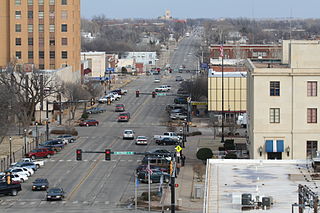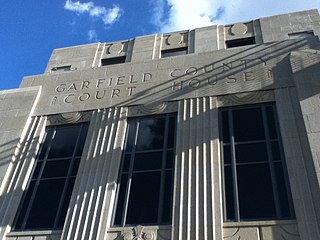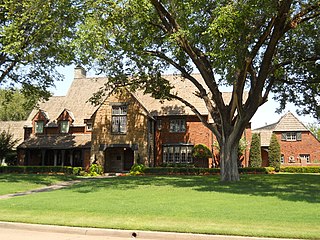
Enid is the ninth-largest city in the U.S. state of Oklahoma. It is the county seat of Garfield County. As of the 2020 census, the population was 51,308. Enid was founded during the opening of the Cherokee Outlet in the Land Run of 1893, and is named after Enid, a character in Alfred, Lord Tennyson's Idylls of the King. In 1991, the Oklahoma state legislature designated Enid the "purple martin capital of Oklahoma." Enid holds the nickname of "Queen Wheat City" and "Wheat Capital" of Oklahoma and the United States for its immense grain storage capacity, and has the third-largest grain storage capacity in the world.
Marquis James was an American journalist and author, twice awarded the Pulitzer Prize for his works The Raven: A Biography of Sam Houston and The Life of Andrew Jackson.

John Newbold Camp, known as Happy Camp was an American politician and a Republican U.S. Representative from Oklahoma.

The Old Town Cemetery is located in the city of Newburgh, New York, behind Calvary Presbyterian Church on South Street. It was established in 1713 by Palatine German refugees from the Rhineland-Palatinate who were transported from England in 1710 and settled on the site of the present city of Newburgh. The cemetery is within a section of the city known as the Glebe, a 500-acre (2 km²) grant made by Queen Anne to provide for a schoolmaster and clergyman for these German families. A church built by the Palatines was located on the western edge of the site, on what is now Liberty Street. As the Old Town Cemetery and Palatine Church Site, it was listed as a historic district on the National Register of Historic Places in 2000. It is also a contributing element in the larger Montgomery-Grand-Liberty Streets Historic District.

Magnolia Cemetery is a historic city cemetery located in Mobile, Alabama. Filled with many elaborate Victorian-era monuments, it spans more than 100 acres (40 ha). It served as Mobile's primary, and almost exclusive, burial place during the 19th century. It is the final resting place for many of Mobile's 19th- and early 20th-century citizens. The cemetery is roughly bounded by Frye Street to the north, Gayle Street to the east, and Ann Street to the west. Virginia Street originally formed the southern border before the cemetery was expanded and now cuts east–west through the center of the cemetery. Magnolia contains more than 80,000 burials and remains an active, though very limited, burial site today.

Oakwood Cemetery is a nonsectarian rural cemetery in northeastern Troy, New York, United States. It operates under the direction of the Troy Cemetery Association, a non-profit board of directors that deals strictly with the operation of the cemetery. It was established in 1848 in response to the growing rural cemetery movement in New England and went into service in 1850. The cemetery was designed by architect John C. Sidney and underwent its greatest development in the late 19th century under superintendent John Boetcher, who incorporated rare foliage and a clear landscape design strategy. Oakwood was the fourth rural cemetery opened in New York and its governing body was the first rural cemetery association created in the state.

This is a list of the National Register of Historic Places listings in Garfield County, Oklahoma.

The Broadway Tower, located in the Enid Downtown Historic District in Enid, Oklahoma, was constructed in 1931 by McMillen and Shelton Construction Company. The Broadway Development Company hired George Ernst von Blumenauer of Enid, and the Oklahoma City firm Layton, Hicks, and Forsythe to design the building, in the Art Deco style.

The Garfield County Courthouse is a historic courthouse building located in Enid, Oklahoma. It is on the National Register of Historic Places both individually and as a part of the Enid Downtown Historic District.

The H.H. Champlin House is a two-and-one half-story sandstone building designed in the Tudor Revival style. The house, completed in 1939, is located at 612 S. Tyler in Enid, Oklahoma. It is located within the Kisner Heights addition to the city of Enid, developed from farmland formerly owned by R.H. Kisner. Architects Roy Shaw and Norris Wheeler designed the house. The D.C. Bass Company constructed the main house with walls of Briar Hill sandstone and Vermont slate roofing and terrace. A variety of windows were custom made for the house by Kawneer Company of Niles, Michigan. Jacoby Art Glass Company of St. Louis, Missouri created art glass insets for the Tudor arch windows, featuring scenes from Oklahoma history. The property also includes a carport and greenhouse. The property is currently owned by Enid businessman and attorney James Sears Bryant.

The Enid Masonic Temple, is a historic building in Enid, Oklahoma. It is the home of the Enid Symphony Orchestra, and was listed on the National Register of Historic Places in 1984. The Italian Renaissance Revival building is also located within the Enid Downtown Historic District which became listed on the register in 2007.

The Enid Downtown Historic District is located in Enid, Oklahoma and listed on the National Register of Historic Places since 2007. In 2019 the district was expanded from 7 blocks to 21. The district includes the original downtown plat from 1893, part of the Jonesville addition plat from 1898, and part of the Weatherly addition plat from 1902.

The Lamerton House is a historic house constructed in 1930 located on the 40-acre (16 ha) Lamerton Terrace property Enid, Oklahoma in Garfield County.

New Mount Sinai Cemetery is a 52-acre (21 ha) cemetery in St. Louis, Missouri. Its first burial was in 1853, and its rural cemetery landscape design was laid out in 1907. It was listed on the National Register of Historic Places in 2005. As of the 2005 listing, the cemetery also has a Modern-style community mausoleum, three private mausoleums, and a formal Japanese garden.

The Medford IOOF Cemetery in Medford, Oregon, also known as Medford Odd Fellows Cemetery and as Eastwood–IOOF Cemetery, was founded in 1890. The cemetery was managed by the IOOF Lodge until 1969 where maintenance was transferred to the City of Medford, where it remains today.

The Public Library of Enid and Garfield County, founded in 1899, is a public library located in Enid, Oklahoma, the county seat of Garfield County, Oklahoma.

Oakdale Memorial Gardens, formerly Oakdale Cemetery, is located in east-central Davenport, Iowa. It contains a section for the burial of pets called the Love of Animals Petland. In 2015, the cemetery was listed as an historic district on the National Register of Historic Places, and as a local landmark on the Davenport Register of Historic Properties. It is also listed on the Network to Freedom, a National Park Service registry for sites associated with the Underground Railroad.

The Martin Ryerson Tomb is an Egyptian Revival style mausoleum designed by Louis Sullivan and completed in 1889. It is in the historic Graceland Cemetery in Chicago, Illinois, United States.

West Point Cemetery, also known as Potter's Field and Calvary Cemetery, is a historic cemetery and national historic district located at Norfolk, Virginia. It encompasses three contributing sites, one contributing structure, and one contributing object in an African American graveyard in downtown Norfolk. The cemetery was established in 1873, and includes a grouping of headstones marking the remains of 58 black soldiers and sailors who served in the American Civil War, and a monument honoring these veterans stands over their graves. Other notable elements include the Potter's Field, O’Rourke Mausoleum, and the West Point Cemetery entry sign.























